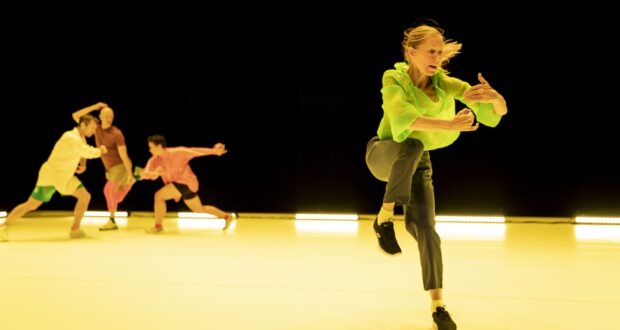Elixir Festival 2024
An intriguing exploration into spontaneity, dance and a story that never ends.
Summary
Rating
Good
Elixir Festival takes over Sadler’s Wells from 10–20 April with a series of performances, workshops, talks, and films that challenge perceptions around dance and ageing.
As part of the festival Dance On Ensemble present two performances London Story and never ending (Story). Founded in 2015 by Berlin-based cultural organisation Bureau Ritter, Dance On Ensemble aims to develop a rich and ambitious repertoire for dancers aged 40 plus and celebrate their experience and excellence.
The production is split into two thirty minute performances beginning with London Story, based on the original 1963 show Story by Merce Cunningham. Cunningham’s Story is seen as one of his most improvisational pieces, known for being an indeterminate work reconfigured for each show, using both chance operations and in-performance decision making. Archival records of Story are limited so Dance On Ensemble has created a re-imagination of the piece.
There’s an intriguing aesthetic to this production. A pile of clothes is presented upstage. Above them hangs one of two boards charting time stamps, performance notes and names with the other hanging stage right. Stage left is a large digital clock placed in front of a musician. As the score (composed by Toshi Ichiyanagi) begins, the digital timer silently ticks away while the dancers intermittently enter the stage. This is where the scope of the production gains clarity. The writing on the boards is a guideline informing the audience what will happen and when. It’s absorbing to watch each minute pass and assess whether the dancers transition in accordance with the time frame depicted above.
As the troupe move with and around one another donning and discarding clothing from the pile, it’s not obvious that this is an indefinitely choreographed piece. It flows cohesively with no stark indication of what is or isn’t improvised. This is a positive reflection on how seamlessly the ensemble gel as a collective. During the performance, stick figures depicted in motion are illustrated around the stage using tape. Their static actions gradually proliferate the space around the dancers and draw parallels between their constructed stillness and the energy on stage; each equally dynamic in appearance. As the blackout descends and the performers exit, the stick figures remain, phosphorescently emanating in the dark; vibrant as though they themselves may move at any moment.
The second performance, never ending (Story), is choreographed by Mathilde Monnier who performs in both works. Monnier states, “The work of Merce Cunningham has always been important to me and the opportunity to work from a piece so rare and so little seen…reinforces my interest.” Monnier’s choreography is in response to Cunningham’s Story and uses the poetry of David Antin (a contemporary of Cunningham and John Cage) to create an amusing and provocative exhibition. Much like the title suggests, the ensemble is ever moving – not as expressively as in London Story, but more concentrated and uniform. The tap of their feet in unison creates a hypnotic rhythm as they constantly shift in formation like pieces on a chess board. The contrast between the poetry and incongruent movements often creates moments of genuine humour, yet neither component strives to undermine the significance of the other.
In contrast to Cunningham’s spontaneous piece, Monnier’s response is much more bounded in composition. The two side by side make for a unique and thought-provoking insight into how the environment can influence movement and its interpretation.
The strength and grace of these dancers seems to effortlessly translate through their performance and it’s exciting to see Sadler’s Wells salute their experience, contribution and influence within the arts through this diversely talented Festival.
London Story
Cast: Ty Boomershine, Emma Lewis, Gesine Moog, Tim Persent, Jone San Martin, Marco Volta
Choreography by: Merce Cunningham
Composed by: Toshi Ichiyanagi
Live-Music by: Mattef Kuhlmey
Production by: Dance On/Bureau Ritter
never ending (Story)
Cast: Ty Boomershine, Emma Lewis, Gesine Moog, Jone San Martin, Marco Volta
Choreography by: Mathilde Monnier
Light Design by: Martin Beeretz
Sound Design by: Mattef Kuhlmey
Costume by: Mathilde Monnier
Production by: Dance On/Bureau Ritter
In cooperation with Kammerspiele München
The Elixir Festival at Sadler’s Wells runs until 20th April. Further information and booking can be found here.
 Everything Theatre Reviews, interviews and news for theatre lovers, London and beyond
Everything Theatre Reviews, interviews and news for theatre lovers, London and beyond



